Sharks are some of the most fascinating creatures in the ocean and play a vital role in maintaining healthy marine ecosystems worldwide. However, many shark species are currently facing critical endangerment due to a variety of human activities, including overfishing, climate change, and habitat destruction.
According to the IUCN Red List of Threatened Species, there are currently 37 species of sharks that are classified as Critically Endangered. This is, of course, subject to change as populations are monitored and more information becomes available.
Today we are going to explore 10 types of critically endangered sharks. It is important to note that this is just a small sample of the Critically Endangered Shark species, and there are many more out there that are in need of urgent conservation efforts.
10 Critically Endangered Shark Species
1. Angel Shark

Like other shark species Angelsharks give birth to live young.
©LuisMiguelEstevez/Shutterstock.com
The Angel shark is a type of fish that can be found in the Atlantic and Mediterranean seas. These fascinating creatures have a flattened appearance and are known for their angel-like shape, which has earned them their name.
Unfortunately, like many shark species, Angel sharks are currently considered critically endangered. This is primarily due to overfishing, habitat destruction, and other human activities that have impacted their populations.
2. Basking Shark

A basking shark, Cetorhinus maximus, swimming near Coll Island, Scotland. The most impressive feature of the basking shark is its mouth, which opens up to 1 meter wide.
©Martin Prochazkacz/Shutterstock.com
The Basking shark is a species of shark found in all of the world’s oceans. The Basking Shark has a large, gray body that is darker on top and lighter underneath. With a conical snout, 5 gill slits, and a triangular dorsal fin, it often cruises near the surface with its mouth open to filter-feed on plankton. Despite its tiny teeth, its unique appearance makes it easily recognizable. They are known for their slow swimming behavior and filter-feeding habits, as well as being one of the largest fish species in the world.
These incredible creatures are currently considered vulnerable or endangered in several regions, including the Northeast Atlantic and Mediterranean.
3. Dusky Shark
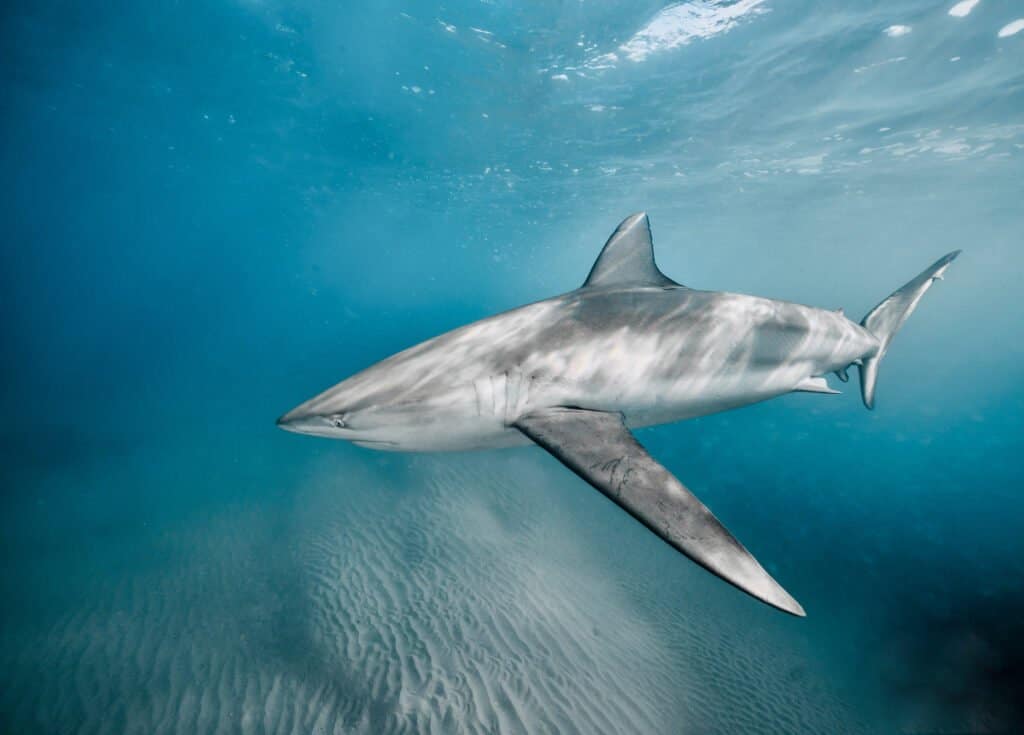
A dusky shark swims in the Mediterranean Sea.
©sirtravelalot/Shutterstock.com
The Dusky shark is a species of large shark found in warm and temperate waters worldwide. It is a large, stocky shark with a long, blunt snout and a rounded dorsal fin with a free rear tip. Its coloring is generally grey or bronze, with a white or lighter underside. It has five gill slits, and its second dorsal fin and anal fin are positioned close to the end of its body. The Dusky Shark is known to have large, sharp teeth and is considered potentially dangerous to humans, although it is not as aggressive as some other shark species.
These sharks are currently considered critically endangered due to overfishing, habitat destruction, and other human activities that impact their populations. These sharks are heavily targeted for their meat and fins, especially in areas like the Western Atlantic and Mediterranean, where their populations have declined significantly in recent years.
4. Great Hammerhead Shark
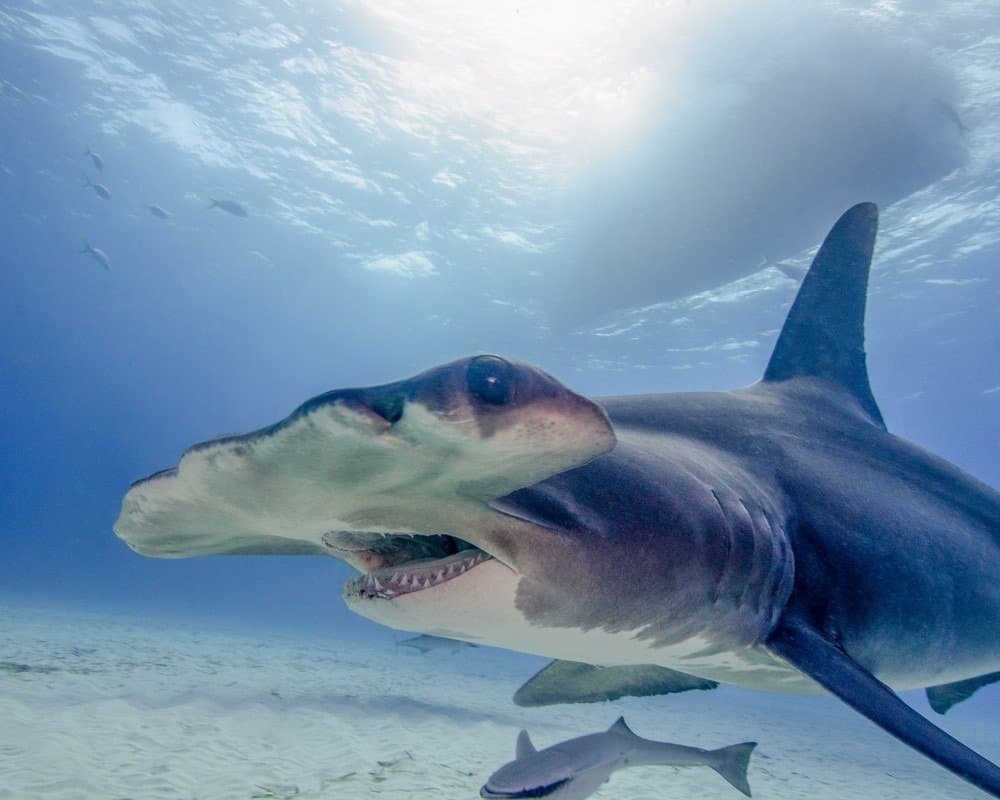
Great Hammerhead Shark in the Bahamas
©Brent Barnes/Shutterstock.com
The Great Hammerhead Shark (Sphyrna mokarran) is the largest of the hammerhead shark species and can be found in tropical and warm temperate waters around the world. They have a distinctive hammer-shaped head that is laterally expanded and flattened. Their body is grayish-brown or olive-green on the upper side with a white belly. They have a tall, curved first dorsal fin and pointed pectoral fins, and their teeth are triangular and serrated.
Sadly, these incredible sharks are currently considered critically endangered, primarily due to overfishing for their fins, meat, and other products, especially in Southeast Asian markets. In addition, habitat destruction, climate change, and pollution are additional threats to their populations.
5. Oceanic Whitetip Shark
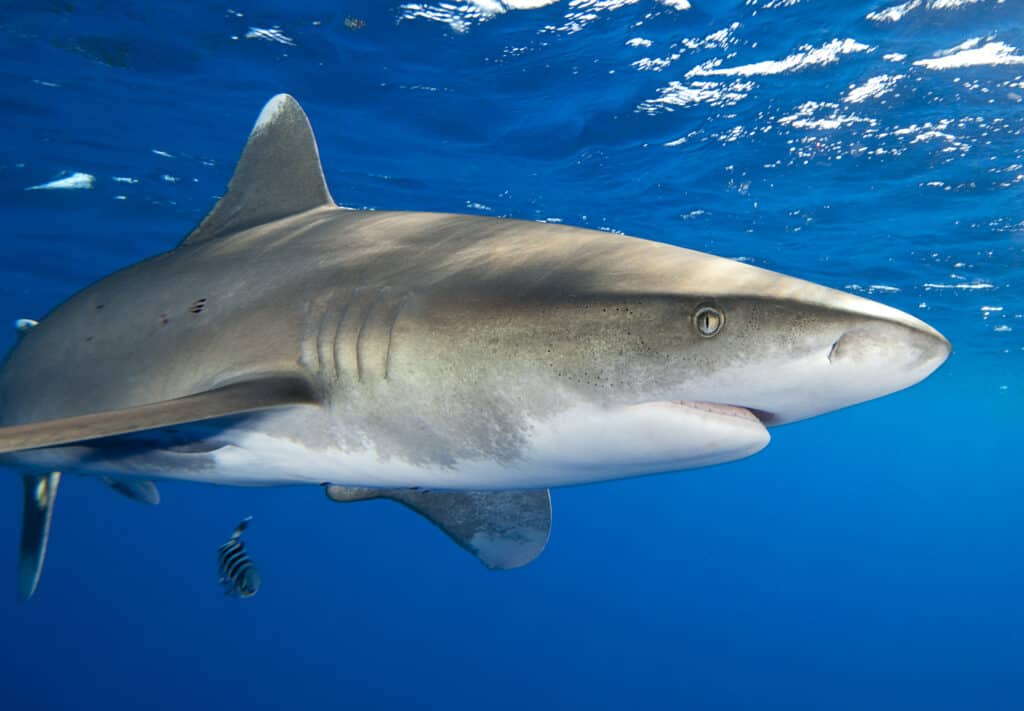
The oceanic whitetip shark is appropriately named due to the white tip on its fin.
©A Cotton Photo/Shutterstock.com
The Oceanic Whitetip Shark (Carcharhinus longimanus) is a large pelagic shark found in the open ocean, particularly in warm waters around the world. They are a stocky shark species with a large, rounded first dorsal fin and long, wide paddle-shaped pectoral fins. Their dorsal side is usually dark grey or blue, sometimes with a bronze tinge, while their ventral side is white, sometimes with a yellow tinge. They have large eyes positioned towards the front of their head, which helps them to home in on prey in low light conditions. The tips of their fins are distinctive, with white coloring that gives them their name.
Unfortunately, these incredible sharks are currently considered critically endangered due to overfishing, specifically for their fins – which are highly valued in Asian markets for shark fin soup. Additionally, bycatch in commercial fisheries and habitat loss are further threats to their populations.
6. Sawfish
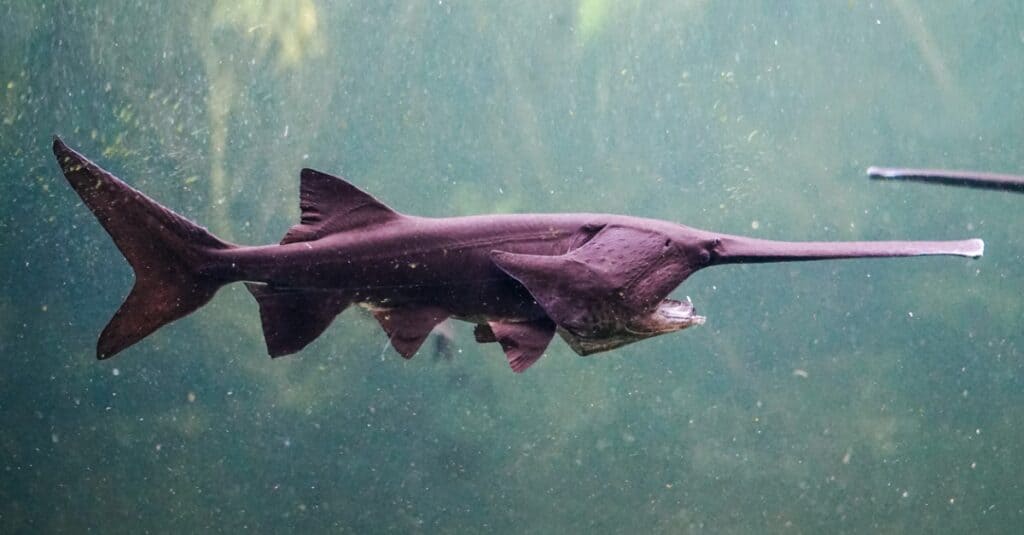
Sawfish use their chainsaw-like nose as a tool for hunting.
©PX Media/Shutterstock.com
The Sawfish Shark is a type of ray that is characterized by its elongated, flattened snout, which is lined with sharp teeth that can be used for hunting. Sawfish generally inhabit shallow coastal waters and estuaries, where they feed on a variety of fish, crustaceans, and mollusks. Unfortunately, sawfish populations are declining worldwide due to overfishing, habitat loss, and accidental capture in fishing gear.
According to the International Union for Conservation of Nature (IUCN), all five species of sawfish are considered either Endangered or Critically Endangered. The smalltooth sawfish, for example, is one of the most endangered species of shark worldwide and is listed as critically endangered by the IUCN. Sawfish are particularly vulnerable to overfishing because of their long, distinctive snouts that make them easy to spot and catch.
7. Scalloped Hammerhead Shark

Scalloped Hammerhead Shark gets its name from its scallop like head.
©Ian Scott/Shutterstock.com
The Scalloped Hammerhead Shark is a species of hammerhead shark that is named for the scalloped appearance of its head. It has a distinct, wide hammer-shaped head with a gray, brown, or bronze color and a white underside for countershading. They grow up to 10-14 feet long and have a tall dorsal fin that is larger than their pectoral fins. The unique indentation on their horizontally expanded head distinguishes them from other hammerhead sharks. They are typically found in warm coastal waters and often form schools during the day.
According to the International Union for Conservation of Nature (IUCN), Scalloped Hammerheads are critically endangered. This is mostly due to overfishing, primarily for their fins, which are highly valued in Asian markets for use in shark fin soup. In addition to being targeted directly, hammerhead sharks are also routinely caught as bycatch in a variety of fisheries. This includes those targeting tuna and swordfish. The loss of coastal habitat and pollution are also contributing factors to their decline.
8. Smooth Hammerhead Shark

Smooth hammerhead shark (Sphyrna zygaena) is considered critically endangered.
©iStock.com/Michael Zeigler
The Smooth Hammerhead Shark is a shark species that typically has a sleek gray or brown body that is slightly rounded in shape. They are distinguished by their smooth, flattened head that lacks the characteristic cephalofoil of other hammerhead species.
Unfortunately, the Smooth Hammerhead Shark is critically endangered due to overfishing and bycatch, as well as habitat loss and degradation. The International Union for Conservation of Nature (IUCN) has listed them as a critically endangered species. This species is also targeted for its meat, fins, and liver oil, which has led to a significant decline in its population.
9. Whale Shark

Whale shark swimming with pilot fish in the ocean.
©Tee Wong/Shutterstock.com
The Whale Shark is a slow-moving, filter-feeding carpet shark and is the largest known fish species in the world. It can grow up to 40 feet in length and weigh up to 20 tons. Despite their size, they feed on plankton and small fish.
Sadly, these magnificent creatures are critically endangered due to overfishing, bycatch, and habitat destruction. They are hunted for their meat, fins, and oil, and also become entangled in fishing gear.
10. White Shark
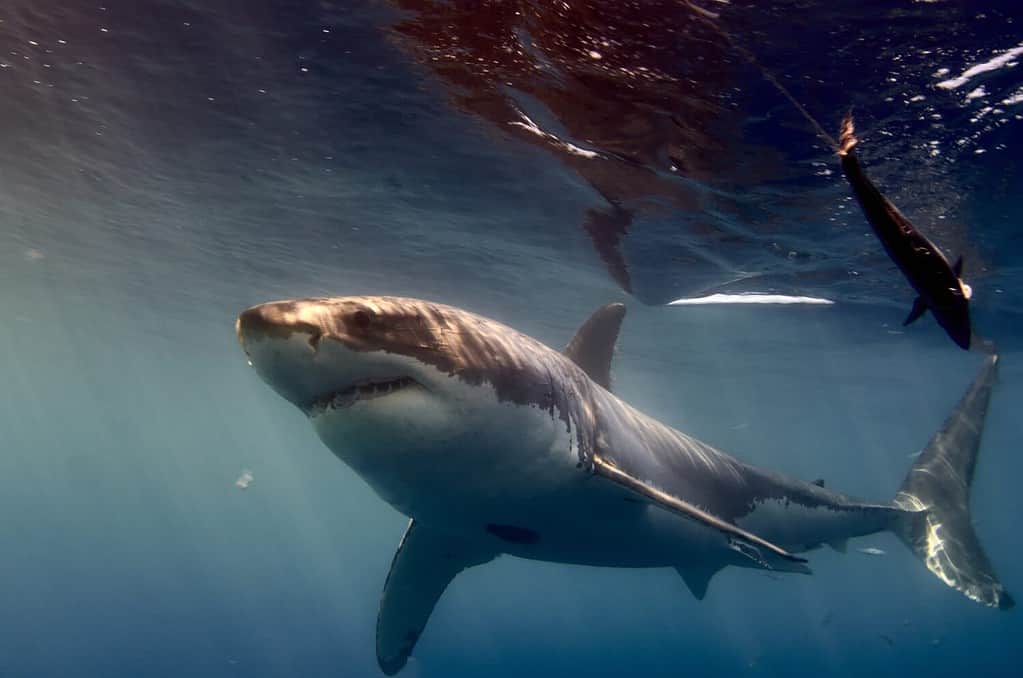
The white shark is also known as the
Great white shark
.
©Wirestock Creators/Shutterstock.com
The White Shark, also known as the Great White Shark, is a large predatory shark that can grow up to 20 feet in length. They are known for their distinctive shape, with a pointed snout and a large dorsal fin. White Sharks are facing a number of threats and are considered a vulnerable species. They are prone to be caught as bycatch in commercial fishing operations. They are also hunted for their fins, teeth, and jaws.
Additionally, their populations are impacted by habitat destruction and degradation, declines in their prey populations, and climate change. Conservation efforts are underway to help protect and restore their populations through measures such as fishing regulations and protected areas.
In Conclusion
Conservation efforts for critically endangered sharks are crucial to protecting these incredible creatures and preserving healthy ocean ecosystems. Without immediate efforts, many of these species could face extinction in the near future. It is crucial that we take action to protect these incredible creatures and preserve the vital role that they play in our oceans.
There are many ways we can help protect these fascinating creatures. For example, there are numerous organizations dedicated to protecting sharks and their habitats. You can support these organizations through donations, memberships, or volunteering.
Climate change and ocean acidification are also major threats to shark populations. By reducing your carbon footprint through actions like using renewable energy, driving less, and eating a more plant-based diet, you can help fight these threats.
Also, the practice of shark finning is a major threat to shark populations worldwide. You can help by avoiding shark fin soup and other shark products. You can also advocate for stronger laws and regulations to prevent the sale and trade of shark fins. When purchasing seafood products, choose sustainably caught or farmed options, and avoid products that contribute to overfishing.
By taking these actions and spreading awareness about the importance of shark conservation, we can all play a role in protecting these incredible creatures and the oceans they call home.
The photo featured at the top of this post is © Sergey Uryadnikov/Shutterstock.com
Thank you for reading! Have some feedback for us? Contact the AZ Animals editorial team.







